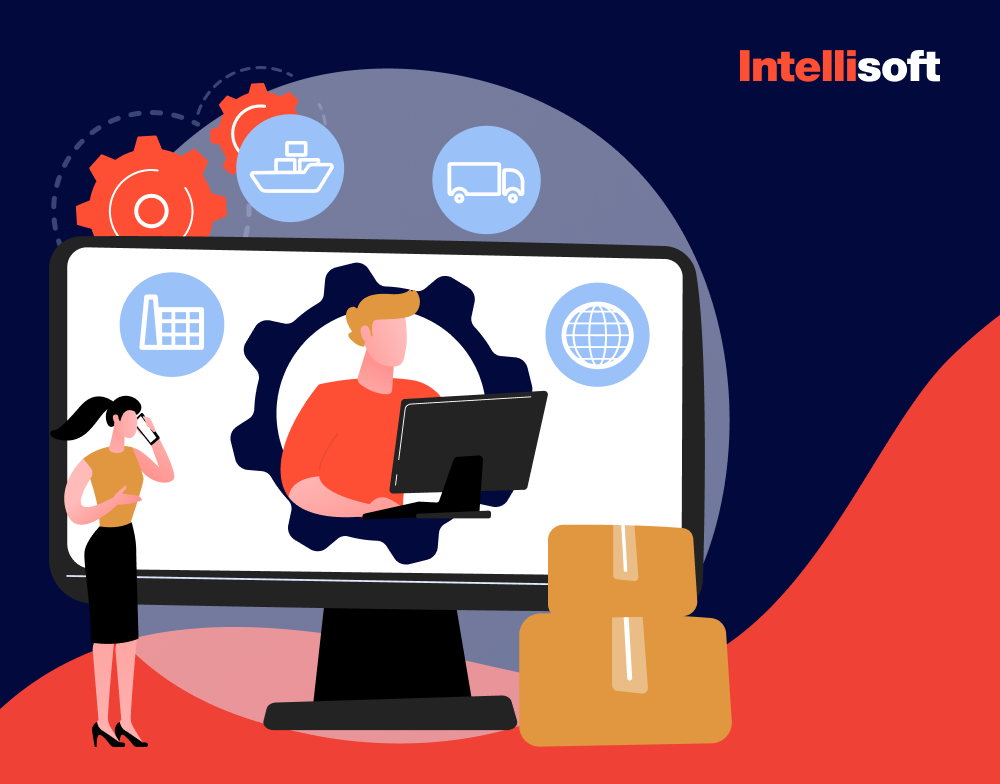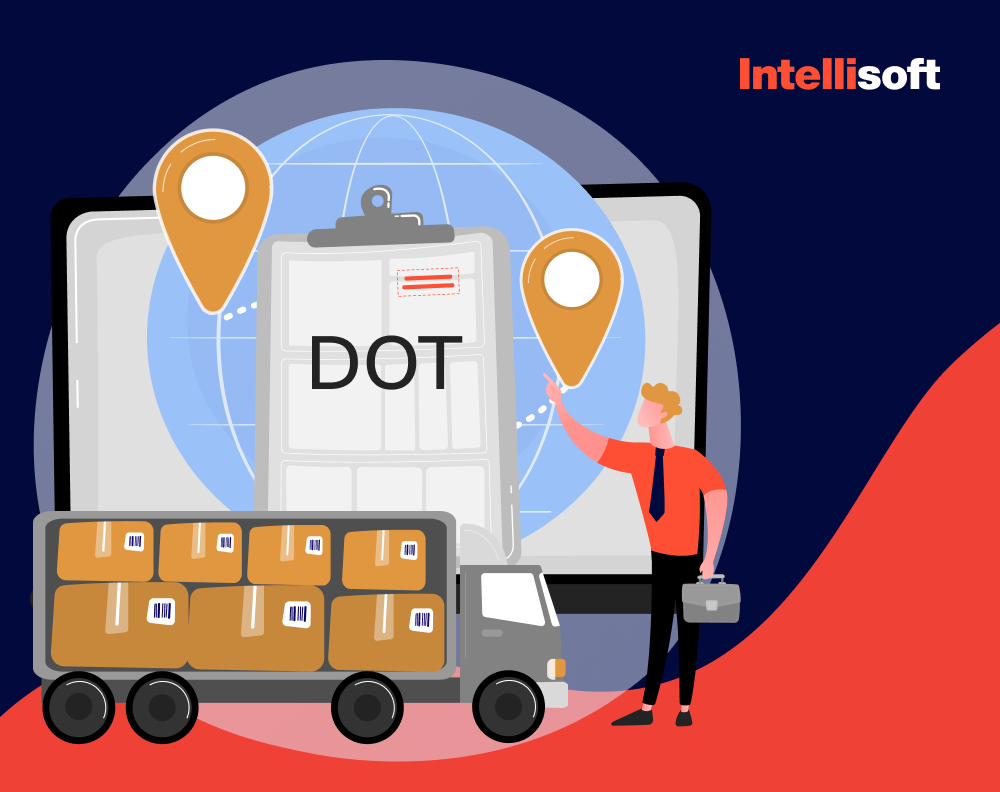In recent years, logistics companies have come to a crucial realization; the reliance on manual processes for warehouse management operations is no longer sustainable. While skilled employees remain integral to organizations, the sheer complexity of operations makes it impossible for them to ensure seamless efficiency through manual handling alone. The human error that leads to delays, low productivity, and issues with resource and time management, made the logistics industry wonder: What can be done to streamline operations and automate operations? That’s what led them to warehouse automation.
The implementation of cutting-edge warehouse automation technology has the potential to significantly boost productivity while simultaneously lowering operational expenses. This fact explains the growing trend among companies to embrace the latest advancements in technology, machinery, and software. By delegating repetitive tasks to these innovations, businesses can liberate their employees’ time, enabling them to concentrate on essential core activities.
Warehouse automation is a multifaceted process, covering multiple tools, technologies, and steps to be taken if you decide to follow this path. At IntelliSoft, we have been working in the logistics industry for more than 15 years, guiding our clients through the mazes of automation tools, artificial intelligence, and IoT – the main players that can help you take your business to the next level. If you are ready to embark on this journey, receive an answer to your question “What is Warehouse Automation?” and turn your warehouse into an automated hub that handles tasks swiftly and efficiently, keep on reading.
Table of Contents
The Role of Technology in Warehousing
The use of advanced technology and the latest tools in multiple industries leads to increased productivity and often reduction in labor and operating costs, and the logistics industry is no exception. Nowadays, logistics clients demand exceptionally fast delivery to their door, and the ability to track their orders, and warehouses need to keep up with the growing demands and change the way they operate, automating and speeding up their processes.
The role of technology in warehousing has changed in recent years due to a number of factors, including:
- Global warming
Global warming is a tremendous factor that has altered the way shipments are moving across the globe. Extreme weather conditions, floods, hurricanes, and heat waves can disrupt shipments, lead to equipment failure, and cause significant delays. Moreover, global warming has led to an increase in energy prices, forcing companies to implement greener, more sustainable operation plans. - The COVID-19 pandemic
When the COVID-19 pandemic hit, people started relying on deliveries more, expecting safe, contactless deliveries of products to their footsteps. At the same time, delivery companies had to minimize human labor and introduce an automated storage and retrieval system. A warehouse automation system allowed to minimize human contact while keeping deliveries running. - Globalization
Because of the widespread use of e-commerce platforms, the market has expanded significantly. Now, people can buy products in any part of the world, benefiting from worldwide delivery, so companies need to automate the processes as much as possible to keep up with the growing demands.
Benefits of Warehouse Automation Technology
Embracing automation in warehouse processes can yield substantial advantages for logistics companies, ranging from heightened efficiency to a noteworthy reduction in human error. Research indicates that automated inventory management systems have the potential to slash labor costs by up to 60% while concurrently boosting output capacity. Let’s delve into the primary benefits of incorporating a warehouse automation system.
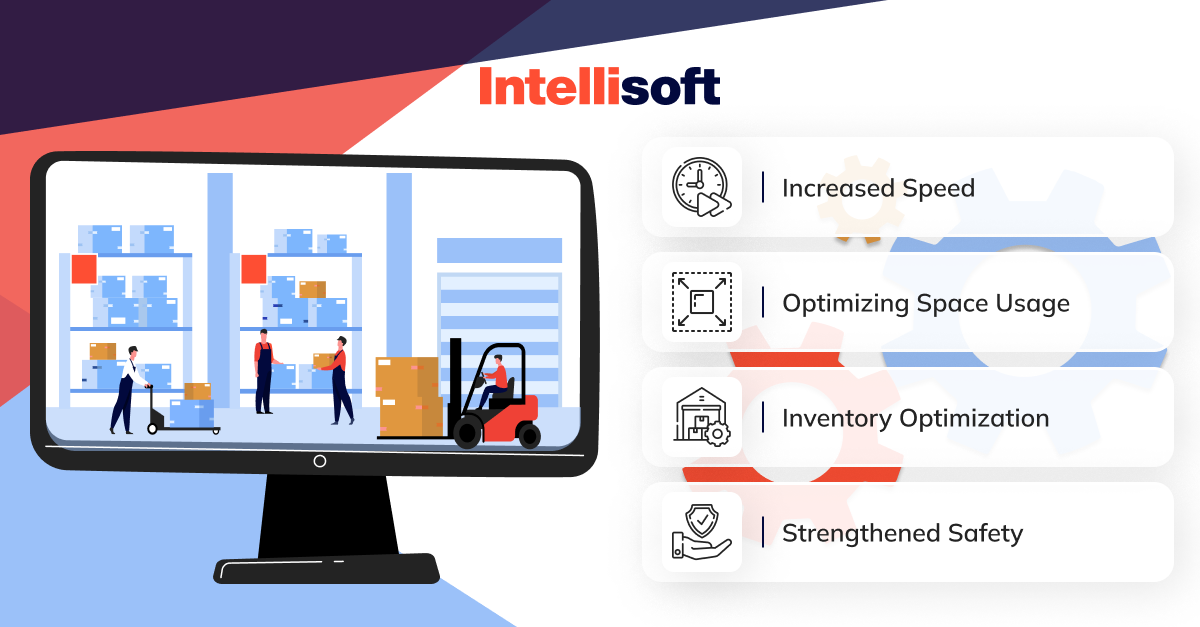
Increased Speed
The first of the benefits of data warehouse automation is increased speed. Automation accelerates warehouse operations, significantly reducing processing times. With the seamless integration of technology, tasks that once took considerable manual effort are executed swiftly and accurately. This integration increased speed enhances order fulfillment and allows quicker response times in adapting to market demands and fluctuations.
Optimizing Space Usage
Warehouse management system automation excels in optimizing spatial resources within warehouses. These systems make the most of available space by strategically organizing inventory and utilizing vertical storage solutions. This type of inventory organization ensures efficient space utilization and facilitates better scalability, allowing warehouses to adapt seamlessly to changing inventory needs and business growth.
Inventory Optimization
Automated systems use advanced tracking and monitoring, reducing the risk of errors in inventory management. This precision minimizes the likelihood of stockouts or overstock situations, leading to a leaner, more cost-effective inventory management process.
Strengthened Safety
When you use a warehouse automation system, it brings products directly to the managers, helping reduce the number of employees and cut down the number of equipment used in the facility. As a result, it increases the safety of the automated processes.
What is Warehouse Automation
Modern warehouses still heavily rely on manual processes; data entry, picking, storing, and shipping goods are still done by hand. These repetitive tasks take a lot of time and effort, resulting in poor efficiency and higher labor and operational costs. Warehouse automation steps into the game, helping your logistics company employees deal with repetitive tasks and cut costs.
Typically, warehouse management system automation encompasses activities such as back-office tasks, barcode scanning, order picking and delivery, and managing handling charges. Warehouse automation is structured into four primary layers:
- Basic automation (use of scanners, printed papers, and applications)
- System automation (mobile radio frequency, WMS, voice-directed tools)
- Mechanized automation (AS/RS, conveyors)
- Advanced automation (palletizer, automatic sorters, robots, AGVs)
To choose the right tools you need for warehouse automation systems, you need to be aware of your current baseline, goals, and budget constraints. Moreover, there are different types of automation tools to choose from, so let’s cover them next.
Types of Warehouse Automation Systems
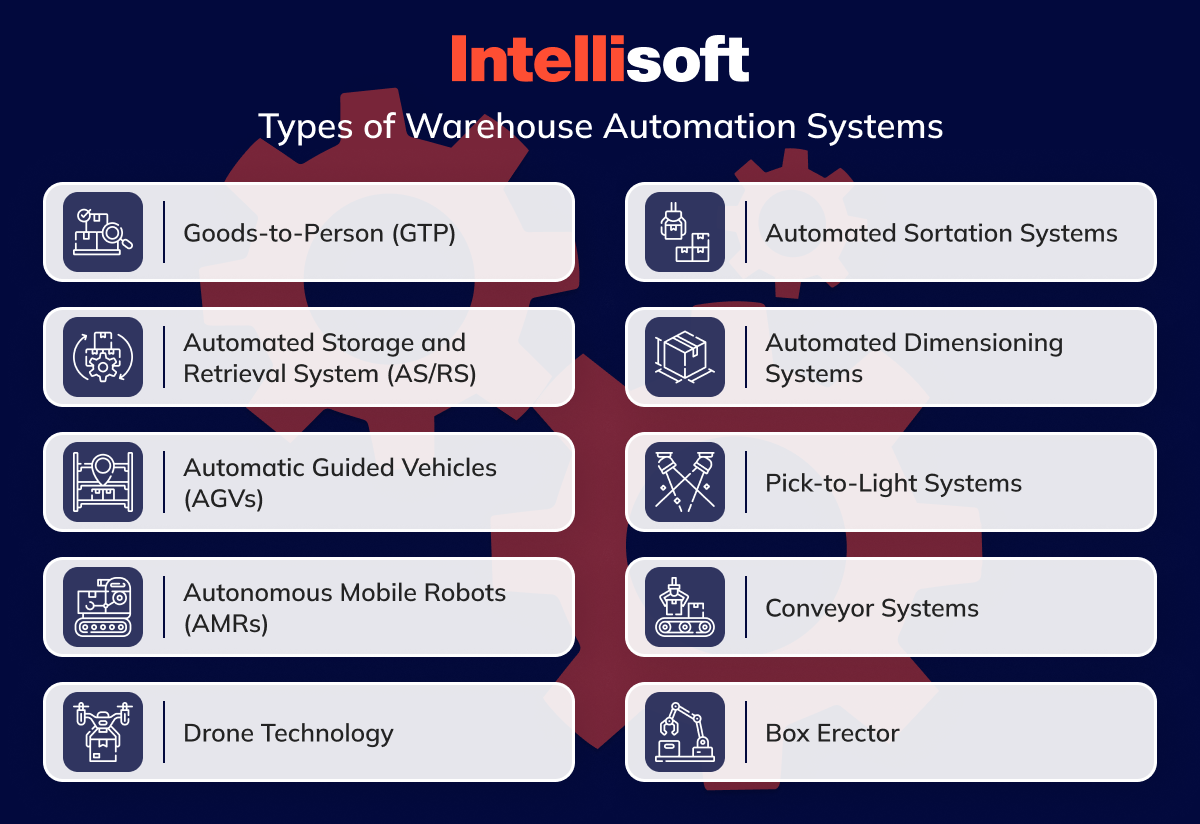
Goods-to-Person (GTP). Revolutionizing warehouse operations, this automation system expedites the retrieval of goods by directly instructing warehouse workers on the precise number of items to pick.
Automated Storage and Retrieval System (AS/RS). Engineered for on-demand storage and retrieval, AS/RS integrates Goods-to-Person technology. This dynamic system combines various technologies, including autonomous mobile robots, carousels, mini-loads, stockers, and shuttles. Interfaced with Warehouse Control Systems (WCS) such as eManager, AS and RS systems optimize space utilization and elevate overall productivity.
Automatic Guided Vehicles (AGVs). Navigating predefined paths in warehouses using magnetic strips, wires, floor markers, or sensors, AGVs are ideal for straightforward yet extensive warehouse layouts.
Autonomous Mobile Robots (AMRs). Outperforming AGVs in intelligence, AMRs, equipped with onboard sensors, safely navigate warehouse environments alongside human workers.
Drone Technology. Harnessing advanced capabilities, drones play a pivotal role in locating and tallying inventory across the entire warehouse. They reach every nook, promptly alerting when items are misplaced or need restocking.
Automated Sortation Systems. With sensors, barcode scanners, and RFID on conveyor systems, these systems efficiently organize items and guide them to assigned warehouse locations.
Automated Dimensioning Systems. Using infrared technology, these systems precisely determine the dimensions of pallets or parcels, optimizing space utilization.
Pick-to-Light Systems. Employing scan codes, pick-to-light systems direct warehouse workers with LED displays to the correct storage locations and provide information on the quantity of items to be picked.
Conveyor Systems. Facilitating swift and efficient material flow handling, automated conveyor systems seamlessly transport goods between different areas within the warehouse.
Box Erector. Simplifying the packaging process, an automated box erector automatically forms, folds, and seals boxes, saving valuable time during construction.
When to Automate Your Warehouse
Optimizing your warehouse through automation is most effective when implemented proactively, ideally before the need arises. A single mishap, such as a delayed or incorrect delivery, can lead to the loss of existing or potential customers. Warehouse automation is an investment in the future that mitigates risks and enhances the overall quality of your logistics.
However, it’s essential to recognize that the window for automating your warehouse is never truly closed.
Signs that it’s the perfect moment to introduce automation to your warehouse operations include:
- High Turnover or Difficulty in Hiring. If you’re grappling with a high turnover rate or facing challenges in hiring warehouse staff, automation can create a more stable work environment and offer predictability in operations.
- Customer Complaints About Errors or Delays. A surge in customer complaints related to incorrect deliveries or delayed orders signals a need for enhanced precision, which automation can deliver.
- Elevated Return Rates. High rates of product returns may indicate issues in order fulfillment or inventory accuracy, both of which can be addressed through automation.
- Space Constraints in the Warehouse. When your warehouse is running out of space to accommodate growing inventory, automation becomes a strategic solution to optimize storage and retrieval processes.
Remember, whether you’re taking a proactive stance or addressing existing challenges, embracing warehouse automation can be a transformative step toward ensuring your logistics operations’ efficiency, accuracy, and scalability.
How Do Automated Warehouses Work?
Automated warehouses transform conventional supply chain processes through cutting-edge technologies such as Goods-to-Person Systems (GTP), Automated Storage and Retrieval System (AS/RS), Autonomous Mobile Robots (AMRs), and more.
- GTP technology streamlines warehouse operations by delivering items directly to workers, reducing the manual retrieval time.
- Automated Storage and Retrieval Systems (AS/RS) incorporate various technologies, such as autonomous mobile robots and shuttles, for on-demand storage and retrieval.
- Drones play a crucial role in inventory management, swiftly locating and counting items throughout the warehouse.
- Automated Sortation Systems simplify item sorting through the use of sensors and barcode scanners on conveyor systems.
- Pick-to-light systems enhance order picking precision by guiding warehouse workers to the correct storage locations through LED displays.
- Conveyor systems efficiently move goods, while box erectors automate the packaging process by seamlessly forming, folding, and sealing boxes.
The main goal of an automated warehouse is to ensure that the enterprise operations of your company meet customers’ needs and demands. Thus, to enhance customer experience, you can automate repetitive tasks such as data gathering, inventory control, and maintenance data analysis.
How Are Automated Warehousing Systems Used?
Companies embrace trends in warehouse automation and adopt smart warehouse technologies primarily to optimize operations, minimize waste, mitigate human error, and enhance facility performance. This strategic approach makes warehouses more resilient and adaptable to market changes. The use of AWS covers:
Automated Receiving
One of the warehouse automation trends is automated receiving. When goods arrive at a warehouse for storage, a crucial process involves assessing, inspecting, and labeling them with details such as quantity, weight, expiration dates, and other pertinent information. However, challenges often arise, including misinformation, incomplete data, or even loss of quantity-related information. A potential solution to mitigate these issues involves utilizing mobile scanners to capture item details and integrate them into a comprehensive inventory database.
The use of barcodes and scanners has eased the burden on warehouse personnel during these tasks. However, the scope extends beyond mere scanning; exploring additional options for data storage and management becomes imperative.
For instance, the implementation of cloud-based software development offers an opportunity to not only store data from incoming orders but also leverage it for more effective capacity management within the facility. This technological integration enhances the warehouse’s operational efficiency by facilitating accurate data capture and strategic utilization for optimizing storage capacity.
Put-Away and Pickup
Automating equipment significantly enhances the efficiency of both the put-away and pickup processes in warehouses. However, the critical role of software solutions in these operations shouldn’t be overlooked. Whether utilizing machines or manual labor, both processes rely on resources. A prevalent trend in warehousing revolves around asset tracking, where the utilization of sensors, tags, and interconnected devices optimizes the product put-away process.
Automated Storing
Another case of warehouse automation trends is automated storing. It may seem that storing goods does not require automation because it is a static process that does not involve many manual processes. Partly, that is true, but storing has a lot of potential for improvement despite being static. Storing allows warehouses to collect huge amounts of data, covering the location of goods, conditions of storage, and availability of goods. All of this information is essential for operational analytics as it allows companies to plan their business strategies.
Shipping
Maintaining strong customer relationships relies heavily on efficient shipping practices. For any warehouse, the primary objective is to attain an impeccable shipping schedule while optimizing the transit time of products. Consequently, shipment and delivery timeline data emerges as a crucial component within operational analytics. This data holds significant value as it contributes directly to refining shipping strategies and achieving optimal delivery timelines, ultimately enhancing customer satisfaction.
Related Readings
- How Predictive Analytics Solutions Are Benefitting Supply Chain
- What Is a Modern Fleet Information Management System?
- How to Develop Logistics Management System: Timeframe, Tech Stack, and Costs
- Machine Learning in Logistics Industry: Benefits and Use Cases
Warehouse Processes That Can Be Automated
The processes that can be automated depend on your current business needs and budget constraints. Typically, warehouse automation technology consists of robotized storage, material flow handling, order-picking tools, and control systems.
Here are the processes that can be automated:

- Inbound. Warehouse automation accelerates this storage process, ensuring heightened speed, enhanced accuracy, and a reduction in space requirements.
- Material flow handling solutions, such as conveyor belts, seamlessly transport items and inventory between different zones within the warehouse.
- Order picking. This is the most time-consuming process in warehousing. It can be automated with warehouse automation solutions that help increase accuracy and speed.
- Returns can also be automated with advanced Automated Sortation Systems.
- Sorting. Automated warehouse solutions significantly enhance the accuracy of sorting processes, ensuring items are efficiently organized and directed to their designated locations with a higher level of precision.
- Packaging. The integration of automated packaging and cartonization systems prioritizes safety during the packaging phase. These systems are designed to reduce the risk of errors and enhance overall safety standards in the packaging process.
- Waste handling. Warehouse automation solutions streamline waste management by automatically and accurately handling waste. This contributes to operational efficiency and ensures a more effective and environmentally conscious waste disposal process within the warehouse.
What Processes Can’t Be Automated
Some processes can’t or shouldn’t be automated. They include:
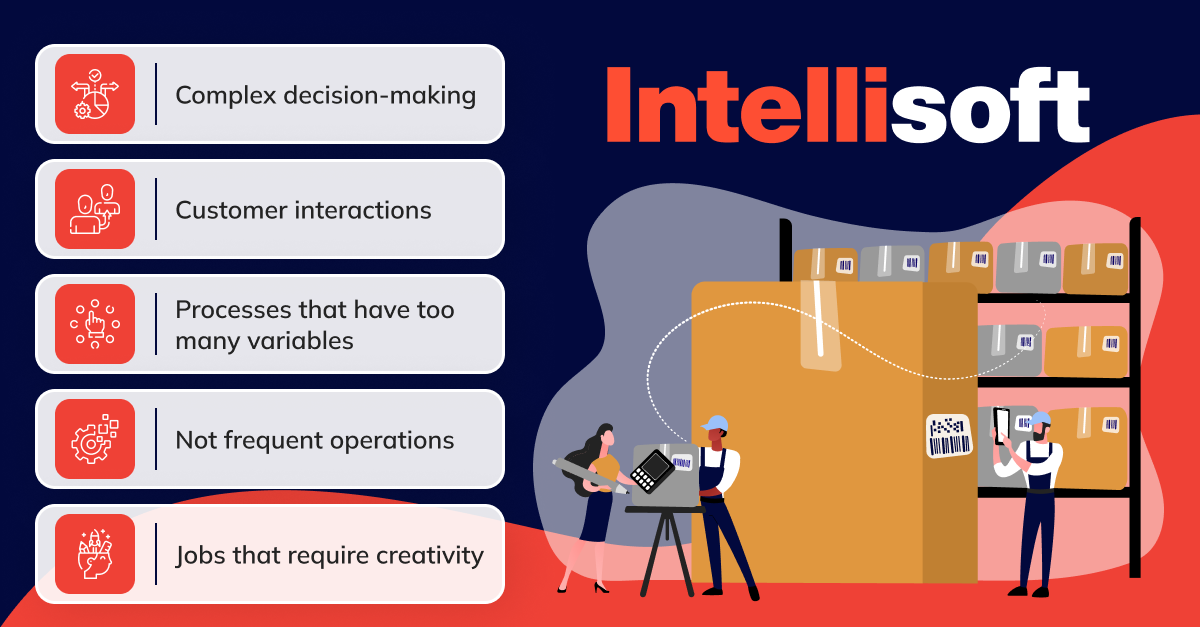
- Complex decision-making. Some decisions require human judgment and are too complex to be handled by automation systems, so it is preferable to leave these tasks to your employees.
- Customer interactions. Helping clients on complex or sensitive issues should also be left to people, while basic queries can be handled by chatbots and automated customer service solutions.
- Processes that have too many variables. If some of the processes at your warehouse require frequent adjustments or have too many variables, automation can complicate them even further. If you want to simplify them, they should be handled by your employees.
- Not frequent operations. Automation works for repetitive tasks, not operations that occur rarely as the ROI on automating them may not justify the money you spend on it.
- Jobs that require creativity. Roles demanding creativity, such as content creation or strategic planning, aren’t conducive to automation. These responsibilities hinge on human ingenuity and expertise, factors that automation cannot replicate.
Top Smart Warehouse Technologies
Warehouse automation technologies range from simple, single-application technologies to end-to-end systems that automate multiple interconnected tasks and processes. We have compiled a list of warehouse technology types, depending on their operational areas, to help you better understand what type of automation technology you can use in your business.
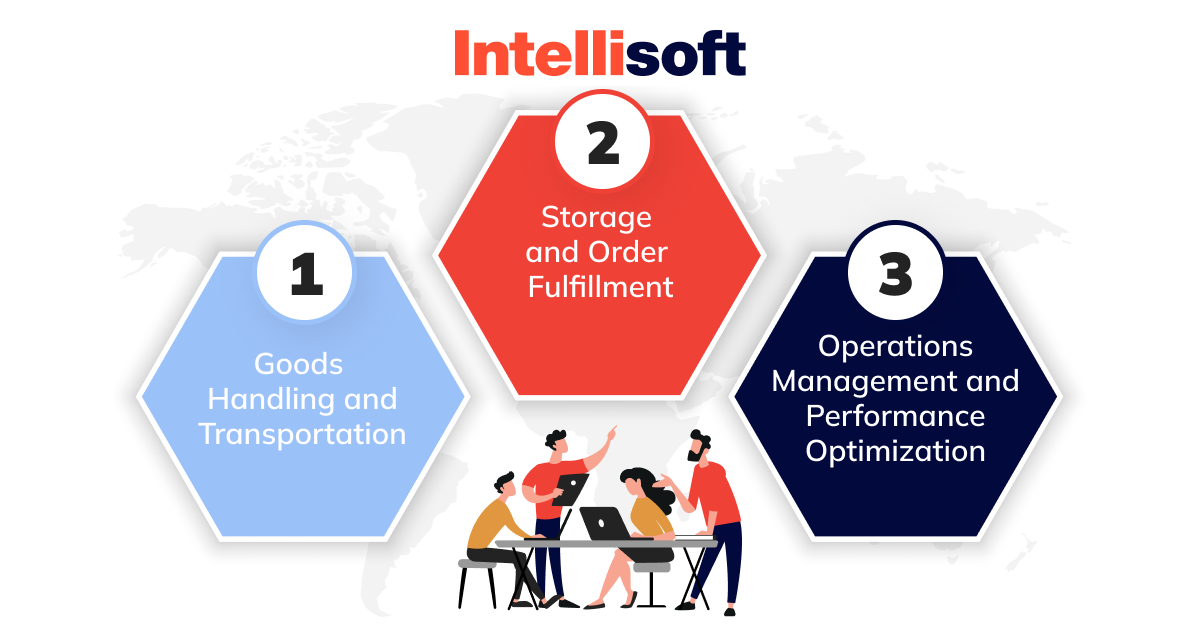
Goods Handling and Transportation
Robotics and Autonomous Mobile Robots (AMRs), Autonomous Guided Vehicles (AGVs)
These technologies include different types of robots and self-driving vehicles that handle and move goods in the warehouse, helping deliver them to employees for faster picking, sorting, and shipment.
Examples:
- Goods-to-person robots that bring items to employees for further handling.
- Automated vehicles that use routes to transport goods from one area of a warehouse to another.
- Autonomous forklifts that move pallets without human help.
Conveyor Systems
If you need to efficiently transfer high volumes of goods around the warehouse, you can utilize smart conveyor systems. These systems can be used to sort goods and send stock to different locations based on defined rules. Another function is accumulation: such conveyors help accumulate stock along the conveyor route.
Storage and Order Fulfillment
Automated Picking Solutions
Order picking can be automated to varying degrees, depending on specific requirements and processes. Here are some examples:
- Pick-to-Light Systems. Utilizing LED lights and sensors, these systems guide workers in selecting items and quantities during the picking process, enhancing accuracy and efficiency.
- Put-to-Light Systems. LED lights indicate precise locations for items to be placed, expediting the process for human workers and improving overall efficiency.
- Voice Picking Systems. Operating in a paperless, hands-free, and eyes-free manner, this system relies on voice commands to guide warehouse workers through picking and put-away tasks. While less common today due to more efficient alternatives, it remains valuable in situations where accessibility is a primary concern.
- Wearables. Devices such as smart glasses or wrist-mounted devices offer visual or audio cues for picking tasks, providing additional support for workers in the fulfillment process.
Some of these systems, such as pick-to-light and put-to-light systems, can be integrated with other warehouse automation systems. For instance, you can connect a goods-to-person system with a pick-to-light system to help your employees select the right items from the inventory bin delivered by the system.
Traditional Automated Storage and Retrieval Systems (AS/RS systems)
AS/RS employs automated mechanisms to store and retrieve inventory items from specified locations within a warehouse or distribution center. These solutions are intricately designed to enhance efficiency, accuracy, and space utilization throughout the storage and retrieval processes.
Integral to AS systems and RS systems is control software that oversees and optimizes the entire workflow. As new stock arrives, it is automatically allocated to predetermined locations within a grid, storage bins, or totes. Robots are then directed along the storage grid to efficiently retrieve items for various purposes, such as picking and order fulfillment. Different subtypes of AS/RS cater to diverse storage requirements and varying order volumes, ensuring a tailored approach to different operational needs.
AS/RS subtypes include:
- Unit-load (for large items)
- Horizontal carousel (for small items)
- Mini load (for small to medium items)
- Vertical lift modules (for tall items)
- Shuttles (for handling trays, totes, and cartons)
Сube Storage
Cube storage is the next generation of traditional AS systems and RS systems. It can also be classified as a goods-to-person fulfillment system that combines several advanced technologies to improve productivity and maximize storage capacity.
The benefits of cube storage solutions include:
- It is the most reliable AS/RS system.
- It is the highest-density AS/RS solution.
- It is easy and quick to implement .
- Cube storage is suitable for various product ranges, depending on the size of the goods
- Inventory items are stored in a three-dimensional fashion, spanning all directions along the grid—both horizontally and vertically. This approach optimizes the maximum cubic airspace available, presenting a
- significant contrast to traditional Automated Storage and Retrieval Systems (AS/RS) that necessitate considerably more floor space to achieve equivalent storage capacity.
- It is modular and easy to scale and adapt, depending on various periods such as holidays and Black Friday sale.
Operations Management and Performance Optimization
Warehouse Management Systems (WMS)
WMS helps integrate and manage different aspects of warehouse operations, such as inventory tracking, labor allocation, order management, and optimization of workflows. Moreover, these systems provide real-time visibility and control over various warehouse activities.
If you want to take your WMS even further, you can utilize enterprise resource planning (ERP) tools and CRMs. If you haven’t adopted a WMS yet, many options are available, each with different levels of complexity. The choice depends on factors such as your specific type of operation, workflow, industry, etc. Therefore, seeking assistance from external consultants before implementation can prove beneficial.
Internet of Things (IoT) Sensors and Automatic Identification and Data Capture (AIDC)
In warehouse automation, the Internet of Things (IoT) serves a multifaceted role. It extends beyond the control of isolated processes, establishing a cohesive system with synchronized data. IoT technology ranges in diverse forms and price ranges from straightforward sensors, or tags affixed to movable warehouse components for performance data collection.
AIDC employs various technologies, including barcodes, RFID (Radio-Frequency Identification), and QR codes, to automatically collect and interpret data. This systematic approach streamlines processes such as inventory management, order fulfillment, and asset tracking. AIDC enhances the speed and accuracy of data capture and contributes to the overall efficiency of supply chain operations.
How to Optimize Warehousing Systems
If you are ready to perform automation of your warehouse system, it is essential to know where to begin. In most cases, the process begins with the overall optimization, which is critical for effective management, no matter the size of the storage. Moreover, you should organize the inventory from the bottom up as it will leave more free space and help you build organic paths for placing machines.
Remember to adopt layouts to keep the traffic flow efficient and support the following functions of your warehouse:
- Cargo storing.
- Incoming processes (receipts, returns of goods) and outgoing processes (picking, shipment).
- Other operations (labeling, applying price stickers, etc).
Now, let’s discover how you can improve your warehouse operations.
Change Aisle Widths
You can change aisle widths by moving storage shelves together. This strategic adjustment optimizes the utilization of available space and empowers your employees to create more room for efficient movement within the warehouse. By narrowing or widening aisles based on operational needs, you not only enhance accessibility for personnel but also create opportunities to maximize storage capacity.
Re-Organize Inventory
It often happens that you place similar goods together. In some cases, this approach can work, but storing the items according to the demand is more efficient. For instance, place fast-moving items closer to the shipping lanes.
Remove Unsold Goods
If you’re not new to the industry, both you and your employees must know which items sell better and what stays on the shelves. Thus, make sure to remove the goods that have little to no demand, as it will help you save space for better-selling products.
Measure Travel Time
Too much free space is not always great, as employees need more time to find where specific items are located. Thus, measure how much time it takes to move in the warehouse to find goods and ship them. Ensure that it takes as little time as possible if you want to avoid delays and optimize operations.
Steps to Designing Your Warehouse Management Software
Once the time comes to embark on a journey to create your warehouse management software, you should have a clear understanding of what this process presupposes. Each step in this journey should contribute to the development of a tailored and effective solution that aligns with the unique requirements of your warehouse management.
Gather Your Requirements
First, you should focus on gathering all your requirements, needs, and expectations from the software you’re about to develop. Assess your warehouse management system and notice any gaps that need to be filled with the solution and what problems it will address. Define your real-time tracking demands and any other functionalities critical to your warehouse operations’ success.
Hire Developers
Selecting a skilled and experienced team of developers is a crucial next step. Collaborate with software development professionals who specialize in warehouse management software and possess a profound understanding of the intricacies of your industry. A dedicated and knowledgeable development team is essential for translating your unique business requirements into a functional and tailored software solution.
Launch Discovery Phase
The next crucial step is the discovery phase – it will allow you to delve into the details of your warehouse processes and offer a comprehensive, in-depth analysis of your potential challenges and opportunities. Through this exploration, you lay the foundation for a system that addresses current needs and anticipates and accommodates future developments in your warehouse operations.
Develop Warehouse Automation Software
The insights gained during the discovery phase will serve as a basis for the development process. During this stage, your development team will start creating your warehouse management software, focusing on coding, rigorous testing, and continuous refinement to ensure that the system seamlessly aligns with the nuances of your operational workflow.
Integrate Software Into Your Ecosystem
Upon successful development, the focus shifts to the integration of the warehouse automation software into your existing business ecosystem. This step ensures a harmonious and efficient interaction with other essential business systems, promoting a cohesive operational environment that maximizes productivity.
Continue to Monitor the System
Post-implementation, establish a robust monitoring system to track the ongoing performance of your warehouse management software. Regular assessments and proactive monitoring allow for the identification of any potential issues, enabling swift resolution and the implementation of updates or enhancements as needed. This process helps ensure that your software is efficient, relevant, and adaptable to changing demands and market trends.
Conclusion
The logistics industry is undergoing a serious paradigm shift, recognizing the inefficiencies of manual processes in warehouse management. The operations these days become incredibly complex and the demands for efficiency grow as well, making logistics companies think about adopting warehouse automation. Warehouse automation is the secret ingredient to staying on top of the competition in the logistics landscape, boosting productivity, and reducing operational costs.
With automation software, there’s no universal approach that will be a perfect match for all logistics companies. Your goal is to understand your needs and requirements and develop a solution that will address your unique issues. Fortunately, you don’t have to figure everything out alone; our 15 years of experience in the industry will allow us to guide you with the expertise and skills necessary to transform your warehouse into the next-generation automated hub. If you are ready to optimize your warehouse operations with cutting-edge automation, contact us, and let’s embark on this exciting journey.








